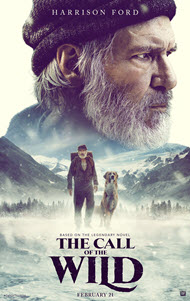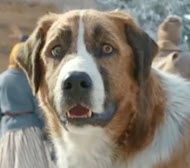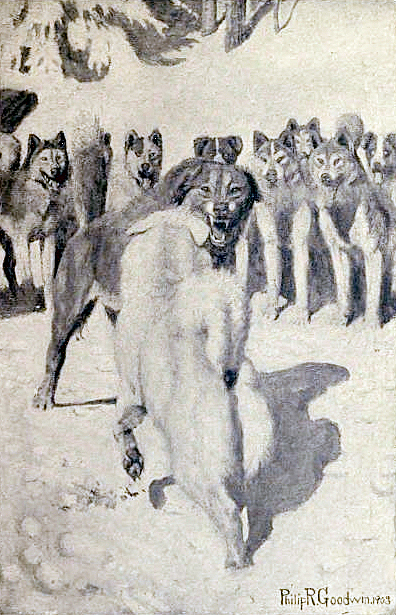The Call of the Wild
 for some violence, peril, thematic elements and mild language.
for some violence, peril, thematic elements and mild language.
Reviewed by: Blake Wilson
CONTRIBUTOR
| Moral Rating: | Average |
| Moviemaking Quality: |
|
| Primary Audience: | Adults Young-Adults Teens Family |
| Genre: | Adventure Drama Adaptation |
| Length: | 1 hr. 40 min. |
| Year of Release: | 2020 |
| USA Release: |
February 21, 2020 (wide release) DVD: May 12, 2020 |







The value of persistence, perseverance and hard-work
Overcoming daily difficulties, hardships and dangers in a fallen world
Love in action between a man and dog

Working dogs / sled dog life
A dog adapting to its new life—from being a pampered pet to a lead sled dog and eventually a feral dog living with wolves

Working at removing selfishness from our lives / Putting the needs of others ahead of our own
For a follower of Christ, what is LOVE—a feeling, an emotion, or an action? Answer
The sin of stealing someone’s pet dog
The brutality that is evident on a daily basis in fallen human beings
About the fall of mankind to worldwide depravity

Life in the Alaskan Yukon during the Gold Rush
Experienced woodsmen compared to people who are unprepared and unsuited to life in the winter wilderness of Alaska
Gold in the Bible
The results of the love of money / greed
People who are unprepared and unsuited to life in the winter wilderness of Alaska

Experiencing the death of a son and the dissolution of a marriage as a result
Becoming a recluse
Being filled with regrets
Seeking emotional and spiritual peace
The danger of using alcohol to cope with grief

WHY IS THE WORLD THE WAY IT IS? If God is all-knowing, all-powerful, and loving, would He really create a world like this? (filled with oppression, suffering, death and cruelty) Answer

ORIGIN OF BAD THINGS—Why are they in our world if a good God created us? Answer
The purpose of fictional stories that anthropomorphize and allegorize animals, giving them human traits that are not truly realistic
| Featuring |
|---|
|
Harrison Ford … John Thornton Karen Gillan … Mercedes Cara Gee … Françoise Dan Stevens … Hal Bradley Whitford … Judge Miller Jean Louisa Kelly … Katie Miller Wes Brown … Mountie Omar Sy … Perrault Terry Notary … Buck the dog (through motion capture) See all » |
| Director |
|
Chris Sanders |
| Producer |
|
3 Arts Entertainment Twentieth Century Fox Animation Twentieth Century Fox See all » |
| Distributor |
It’s clear from the beginning that the dog Buck doesn’t fit in at home. He causes a lot of ruckus and trouble for his family. To make matters worse, one day Buck is stolen by someone desperate for money and finds himself held hostage. Later, he escapes, only to find himself captured again and put up for sale.
Buck is then adopted by a kind couple (Omar Sy and Cara Gee), and becomes part of a team of sled dogs to help deliver mail. After a rough start, Buck builds his way to becoming leader of the pack. It’s a good life for him, until one day his owners are terminated from their job, as the telegram becomes more popular.
Buck and his dog pack are then adopted by a high-class individual (Dan Stevens) who seems to know nothing about taking care of sled dogs. Upon pushing the dogs to their breaking point, Buck is cut loose and rescued by a loner named John Thornton (Harrison Ford).
Entertainment Quality
The visual effects and camerawork are pretty impressive. From swooping backgrounds to well-paced action scenes, the crew did a great job making the adventure as realistic as possible. The CGI tricks don’t always work. There are times where Buck’s digital appearance is obvious, but he’s still among the most impressive visual creations I’ve seen. But at least for the films’ first two thirds, it remains exciting and entertaining.
As John, Ford gives a fairly memorable performance. In addition to a few moments of his classic “Han Solo” sarcasm, he gives the film a terrific sense of wit and emotional pathos as well. At 77 years old, he shows he can carry a movie very nicely (although he actually doesn’t play a big part until about half-way through). Sy and Gee are excellent casting choices for the couple that adopts Buck first, while Stevens is appropriately villainous. However, his character appears too late in the film to really develop into a proper antagonist.
Accompanying the performances, visual effects and cinematography is composer John Powell’s terrific score. He gives the right amount of excitement to the strong moments and the right amount of subtlety to the softer ones. And despite the strong action scenes, the film pauses long enough to make sure the characters receive enough time to develop.
On the downside, the film’s last act does lose some of the film’s overall luster. The structure of the film’s ending is a bit odd, as it rushes through a couple of key moments in the story. This prevents it from being as emotionally effective as it could have been. A simpler ending, with less going on, might have been even more effective.
Positive Messages
The value of persistence and perseverance is the main positive message. Buck provides an excellent example of that character trait. He works hard and earns the trust of his masters the old-fashioned way. And at the same time, he thinks of others’ needs ahead of his own. This trait rubs off on John, who has given up on everything in his life. Buck inspires him to get back on his feet and live his life for others instead of himself. Philippians 2:4 talks about how it is important to look out for others ahead of ourselves…
“Let each of you look not only to his own interests, but also to the interests of others.” —Philippians 2:4
Besides that, Buck risks his life multiple times to save the ones he cares about. Selfishness and jealousy are all portrayed as negative character traits through a rival leader. Also, the film encourages us to treat others (including animals) with love and encouragement. This balance and comparison is seen through the couple in a positive light, and the villain of the story in a negative light.
Negative Content
LANGUAGE: At the very beginning, a person reacts in anger to Buck’s antics saying (off-camera), “D*** it, creature!” There’s also a use of “h***” and an unfinished, “son of a…”.
ADULT CONTENT: None. The closest we get is a shirtless Harrison Ford swimming in one scene.
DRUGS/ALCOHOL: John clearly has a drinking habit (we see shot glasses and alcohol bottles a handful of times), though Buck tries and eventually succeeds at making him leave it. We see characters holding alcohol filled shot glasses a handful of times. One other scene has John going into a bar, ordering whiskey and drinking it. Others are seen drinking there as well.
VIOLENCE: The MPAA rating mentions “some violence and peril,” which is accurate. There are a handful of scenes that may be too intense for young children. Buck causes some slapstick mayhem at the beginning, knocking people over and causing things to fall and break. We later witness (through shadows only) Buck being cruelly abused by a club.
As he tries to get used to his new job, Buck is shown causing the sled, its owners, and the pack to fall down a small hill and crash in a couple places, throwing its owners on occasion (but they aren’t shown to be hurt too badly). Later on, the head of the pack gets jealous and viciously attacks Buck. It’s relatively bloodless, but involves a lot of snarling, growling, and hard hits. Buck seems nearly dead at one point.
An avalanche occurs, causing some destruction, and sending Buck and his pack fleeing for refuge—narrowly outrunning the chaos. Guns are fired a few times. A person punches and beats up John at a bar. We see a tiny bit of blood on his beard. A rabbit is killed by a villainous sled dog. We hear about a child’s illness and passing. A club is used to abuse dogs into submission. A whip is used at a couple of points to force dogs to mush.
***SPOILER*** An intense ending scene involves a character setting a hut on fire and shooting John in his side. Buck knocks the intruder into the hut as it collapses, while John slowly dies (we see a little bit of blood on his hands and his face). ***END SPOILER***


OTHER: John’s reasons for being out on his own involve some bad personal choices. He abandons his wife after the unexpected loss of his son. Meanwhile, Buck is abused and mistreated throughout his adventure, with one particular owner treating him and his pack very inhumanely for awhile. Buck’s “call” and “listening to his own voice” are personified through a wolf with red eyes in a few scenes. While his appearance is never explained, it is implied that he is a sort of “spirit guide” for Buck. Some talk of “ancestors” a few times, without really going into more spiritual explanations.
Conclusion
Based on the 1903 classic novel by Jack London, this isn’t the first time “Call of the Wild” has been adapted to the big screen. Starting with a silent film in 1923, it has seen multiple versions on TV and in movie theaters over the past century. What makes this version stand out, however, is that it involves animals that are all CGI and digitally-created. While this decision wasn’t applauded by everyone, it was intentional by the filmmakers as they believed certain situations in the movie would be too much for real dogs to perform.
The familiarity of the novel and Ford’s star-power aside, this movie interested me mostly because it featured animation director Chris Sanders (“Lilo and Stitch,” “How to Train Your Dragon,” “The Croods”) making his live-action debut. Sanders embraces a clever balance between witty enthusiasm and more serious and down-to-earth themes in his directing style, which he successfully brings here. Having worked with the “human-and-his pet” theme twice before, he seemed like a perfect choice to adapt this material.
A couple of mild criticisms notwithstanding, the end result here is a very solid movie. Sanders and crew manage to create stunning action scenes that succeeded in keeping me on the edge of my seat, while providing enough substance in the right moments to help you care for the characters. And I found the CGI work to be more impressive and evoke more empathy and emotion than the recent Lion King remake.
For families looking for something to watch, “Call of the Wild” does carry a few caveats worth a parent’s consideration. There are a handful of scenes that may be too intense and loud for younger children (particularly sensitive moviegoers ages 7 and under). There are also a couple of mild profanities, and some alcohol use, though it’s not shown in a positive light.
So, this “Call of the Wild” may fall short of being an instant classic. But, for older elementary schoolers, families, and movie fans, this version of “Call of the Wild” is still a rollicking, fun, entertaining and heartwarming adventure worth taking.
- Violence: Moderate
- Drugs/Alcohol: Mild
- Profane language: Mild
- Vulgar/Crude language: Mild
- Nudity: Minor
- Occult: Minor
- Sex: None
See list of Relevant Issues—questions-and-answers.


Disturbing moments are the incidences of animal cruelty, but these were kept to a minimum and were tastefully presented. My father told me he couldn’t get through the book because of John’s excessive drinking and how he left his family, but in the film they show how Buck gets him to stop drinking, which was actually kind of cute and funny. They really downplayed these negative moments and tried to explain his personal problems by connecting them to unresolved grief issues, which allows me to rate this movie as better than average.
Someone might think the empathy Buck showed to humans and other animals is unrealistic, but some of the incidents reminded me strongly of the stories my Dad told me about one of his Springer Spaniels as a boy. The part about the fish reminds me of an incident when his dog was duck hunting with his father and a family friend. After giving many of the ducks to my grandfather, she finally looked apologetically at him and gave a duck to the family friend who was having a bad day. So, at first glance, what might seem not to be dog behaviour, is actually realistic with some of the more intelligent dogs.
There are no real faith moments that I remember, but I also don’t remember any swearing. I suppose this story could be symbolic for being the person you are meant to be, and this could be interpreted positively or negatively. I’d recommend this movie which is well acted and has a positive story line. The scenery is also very beautiful.
Moral rating: Better than Average / Moviemaking quality: 4½
Excellent performance by Harrison Ford, and unlike other CGI/ photorealistic animations, this time the animals’ human-like facial expressions add nicely to viewers’ comprehension and entrancement.
Be aware that in addition to the above, alcoholism and death of a child are explored. Nevertheless, these are well handled.
Good usage of your savings for a cinema visit—or a cozy movie night at home.
Moral rating: Good / Moviemaking quality: 4
Moral rating: Good / Moviemaking quality: 5
PLEASE share your observations and insights to be posted here.



My Ratings: Moral rating: Good / Moviemaking quality: 4½